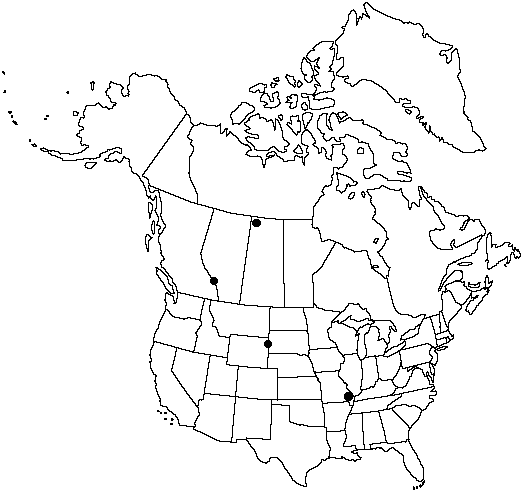Difference between revisions of "Pellaea gastonyi"
Contr. Univ. Michigan Herb. 19: 36. 1993.
FNA>Volume Importer |
FNA>Volume Importer |
||
| Line 16: | Line 16: | ||
}}<!-- | }}<!-- | ||
| − | --><span class="statement" id="st- | + | --><span class="statement" id="st-undefined" data-properties=""><b>Stems </b>compact, ascending, stout, 5–10 mm diam.; scales uniformly reddish brown, linear-subulate, 0.1–0.3 mm wide, thin, margins entire to denticulate. <b>Leaves</b> somewhat dimorphic, sterile leaves shorter than fertile leaves, clustered on stem, 8–25 cm; croziers villous. <b>Petiole</b> reddish purple to dark brown, lustrous, rounded adaxially, without prominent articulation lines. <b>Blade</b> elongate-deltate to lanceolate, 2-pinnate proximally, 3–6 cm wide; rachis purple or brown throughout, straight, rounded adaxially, sparsely villous with long, divergent hairs. <b>Pinnae</b> ascending or perpendicular to rachis, not decurrent on rachis or obscurely so, usually with 3–7 ultimate segments; costae straight, 2–30 mm, usually shorter than ultimate segments. <b>Ultimate</b> segments oblong-lanceolate, 7–30 mm, leathery, sparsely villous abaxially near midrib; margins usually recurved on fertile segments, covering less than 1/2 abaxial surface, borders whitish, crenulate; apex obtuse to slightly mucronate. <b>Veins</b> of ultimate segments obscure. <b>Sporangia</b> long-stalked, containing 32 spores, not intermixed with farina-producing glands.</span><!-- |
-->{{Treatment/Body | -->{{Treatment/Body | ||
| + | |phenology=Sporulating summer–fall. | ||
|habitat=Calcareous cliffs and ledges, usually on limestone | |habitat=Calcareous cliffs and ledges, usually on limestone | ||
|elevation=100–1500 m | |elevation=100–1500 m | ||
| Line 38: | Line 39: | ||
|basionyms= | |basionyms= | ||
|family=Pteridaceae | |family=Pteridaceae | ||
| + | |phenology=Sporulating summer–fall. | ||
|habitat=Calcareous cliffs and ledges, usually on limestone | |habitat=Calcareous cliffs and ledges, usually on limestone | ||
|elevation=100–1500 m | |elevation=100–1500 m | ||
| Line 45: | Line 47: | ||
|publication year=1993 | |publication year=1993 | ||
|special status= | |special status= | ||
| − | |source xml=https://jpend@bitbucket.org/aafc-mbb/fna- | + | |source xml=https://jpend@bitbucket.org/aafc-mbb/fna-data-curation.git/src/9216fc802291cd3df363fd52122300479582ede7/coarse_grained_fna_xml/V2/V2_343.xml |
|genus=Pellaea | |genus=Pellaea | ||
|species=Pellaea gastonyi | |species=Pellaea gastonyi | ||
| − | |||
| − | |||
| − | |||
| − | |||
| − | |||
| − | |||
| − | |||
| − | |||
| − | |||
| − | |||
| − | |||
| − | |||
| − | |||
| − | |||
| − | |||
| − | |||
| − | |||
| − | |||
| − | |||
| − | |||
| − | |||
| − | |||
| − | |||
| − | |||
| − | |||
| − | |||
| − | |||
| − | |||
| − | |||
| − | |||
| − | |||
| − | |||
| − | |||
| − | |||
| − | |||
| − | |||
| − | |||
| − | |||
| − | |||
| − | |||
| − | |||
| − | |||
| − | |||
| − | |||
| − | |||
}}<!-- | }}<!-- | ||
-->[[Category:Treatment]][[Category:Pellaea]] | -->[[Category:Treatment]][[Category:Pellaea]] | ||
Revision as of 13:17, 27 July 2019
Stems compact, ascending, stout, 5–10 mm diam.; scales uniformly reddish brown, linear-subulate, 0.1–0.3 mm wide, thin, margins entire to denticulate. Leaves somewhat dimorphic, sterile leaves shorter than fertile leaves, clustered on stem, 8–25 cm; croziers villous. Petiole reddish purple to dark brown, lustrous, rounded adaxially, without prominent articulation lines. Blade elongate-deltate to lanceolate, 2-pinnate proximally, 3–6 cm wide; rachis purple or brown throughout, straight, rounded adaxially, sparsely villous with long, divergent hairs. Pinnae ascending or perpendicular to rachis, not decurrent on rachis or obscurely so, usually with 3–7 ultimate segments; costae straight, 2–30 mm, usually shorter than ultimate segments. Ultimate segments oblong-lanceolate, 7–30 mm, leathery, sparsely villous abaxially near midrib; margins usually recurved on fertile segments, covering less than 1/2 abaxial surface, borders whitish, crenulate; apex obtuse to slightly mucronate. Veins of ultimate segments obscure. Sporangia long-stalked, containing 32 spores, not intermixed with farina-producing glands.
Phenology: Sporulating summer–fall.
Habitat: Calcareous cliffs and ledges, usually on limestone
Elevation: 100–1500 m
Distribution

Alta., B.C., Sask., Mo., S.Dak., Wyo.
Discussion
Pellaea gastonyi is an apogamous tetraploid that has originated through repeated hybridization between P. atropurpurea and P. glabella. Isozyme studies (G. J. Gastony 1988) indicate that P. glabella subsp. missouriensis was the diploid parent of plants found in Missouri, whereas diploid P. glabella subsp. occidentalis was involved in the origin of P. gastonyi populations occurring in western North America. Pellaea gastonyi is most often confused with P. atropurpurea, from which it differs in having sparsely villous rachises, smaller ultimate segments, and spores averaging more than 62 µm in diameter.
Selected References
None.